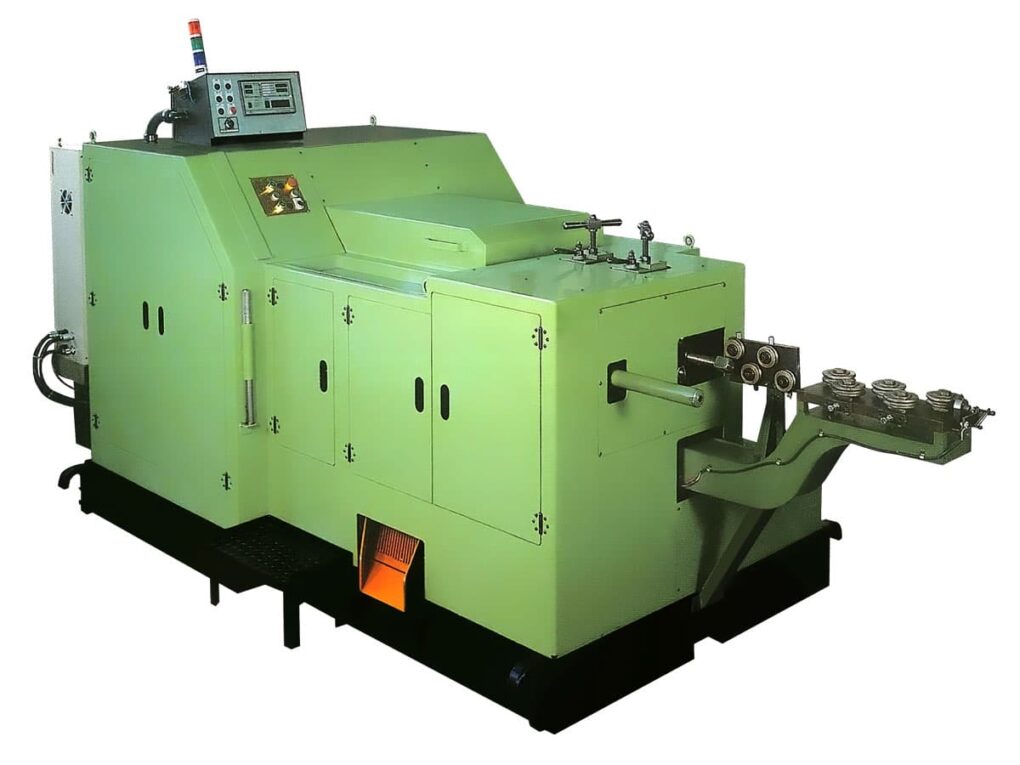Cold heading machines are manufacturing tools that are used for producing precise metal parts by applying compressive forces at room temperature. With the growing demand for high-strength metal components across various industries, cold heading technology is becoming increasingly popular due to its capability to manufacture intricate parts with close dimensional tolerances. This article aims to provide an understanding of cold heading machines, their working principle, applications, and advantages over traditional manufacturing methods.
Types of Cold Heading Machines
There are mainly two types of cold heading machines – single-stroke machines and multi-station machines.
Single-stroke cold heading machines: As the name suggests, these machines complete the cold heading process in a single stroke. They are suitable for low to medium production volumes. A single-stroke machine consists of a die block assembly, striker/ram assembly, blank feed mechanism, and other attachments.
Multi-station Cold Heading Machine: For higher production capacities, multi-station machines are used. In these machines, the cold heading operation is divided into multiple sequential stations. During each stroke, a semifinished part moves from one station to the next until the final shape is achieved. Major parts include a turret assembly with multiple stations, tooling, and an automatic part transfer mechanism.
Working Principle
The basic steps involved in the cold heading process using these machines are:
1. A metal wire or rod known as a blank is fed into the die cavity of the machine.
2. A heavy ram then descends at high speeds and impacts the blank, compressing and forming it into the die cavity shape through compressive deformation.
3. High forming forces ranging between 30-120 tons are applied to extrude the metal and achieve the final dimensions.
4. Once the cycle is complete, the formed part is ejected out and a new blank is fed for the next stroke.
Lubricants like soap or oil are applied in the die cavity and on the blank surface to reduce friction during forming and ensure dimensional accuracy of the finished part. Through this single or multi-stage forming process, complex parts can be cold headed.
Applications
Cold heading is extensively used to manufacture high-volume automotive components like bolts, nails, nuts, dowel pins, shaft clips, and springs. Some other common applications include:
– Fasteners for industrial machinery and equipment manufacturing.
– Pilot pins, rollers for bearing manufacturing.
– Medical device components like spinal screws and needles.
– Precision cold headed parts for electronics, semiconductors and telecom industries.
– Small parts for household items, glassware manufacturing, furniture fittings etc.
– Cold headed safety critical parts for aerospace applications like aircraft screws and bolts.
Capabilities and Advantages
Cold heading enables fabricating intricately shaped components with close dimensional tolerances of ±0.025mm. Some key capabilities and advantages offered by cold heading machines include:
– Production of high-strength parts with hardness levels up to 50 HRC without applying heat treatment.
– Uniform material properties throughout the product since no temperature changes are involved.
– Ability to produce net and near-net shaped parts in a single operation without any trimming or further machining.
– Higher material utilization of over 80% since almost the entire length of the rod or wire blank is used.
– Resultant parts have superior fatigue and wear resistance properties compared to machined ones.
– Significant scrap reduction and efficient material utilization boosts overall productivity and profitability.
– Higher production rates than traditional machining. Cold heading lends itself well for high-volume production environments.
– Consistent part quality and closer dimensional tolerances ensure reliable performance.
– Lower cost per part in high production volumes. Cold heading gives a competitive advantage over traditional manufacturing methods.
– Maintenance of original material characteristics like non-magnetization of stainless-steel parts.
– Ability to form difficult shapes like internal threads and complex contours in difficult to machine alloys.
– Environment friendly manufacturing process producing negligible waste as swarf/chips.
Technological Advancements
Over the years, cold heading machine manufactures have adopted advanced technologies to enhance productivity and capabilities:
– IIoT (Industrial Internet of Things) integration enables remote machine monitoring, predictive maintenance, automatic data collection.
– adoption of servo-driven feed mechanisms and ram drives for higher precision, speeds and force control.
– Multi-slide machines for faster cycle times and complete part production in a single setup.
– Advanced die materials like carbides and ceramics for extended wear life and dimensional stability at high pressures.
– Automatic tool setting and quick die change systems facilitate lightening quick product changeovers.
– CNC (Computer Numerical Control) and PLC (Programmable Logic Control) integration for automated programmable operations.
– In-process quality monitoring technologies like automatic gauging and dimensional inspection aids real-time process control.
– Advanced lubrication systems precisely dose lubricants for improving tool life, productivity and part quality.
– Robotic automation and autonomous guided vehicles (AGVs) for fully unmanned production environments.
cold heading technology has revolutionized small precision component manufacturing. Integration of Industry 4.0 solutions is enabling cold heading machines to operate efficiently even in unpredictable production environments. With advantages like net-shape manufacturing, material optimization, and dimensional accuracy, cold heading will continue dominating high-volume production of critical automotive, industrial, electrical and medical components. Ongoing technological upgrades are further strengthening cold heading as a preferred bulk metal forming process.
*Note:
1. Source: Coherent Market Insights, Public sources, Desk research
2. We have leveraged AI tools to mine information and compile it

